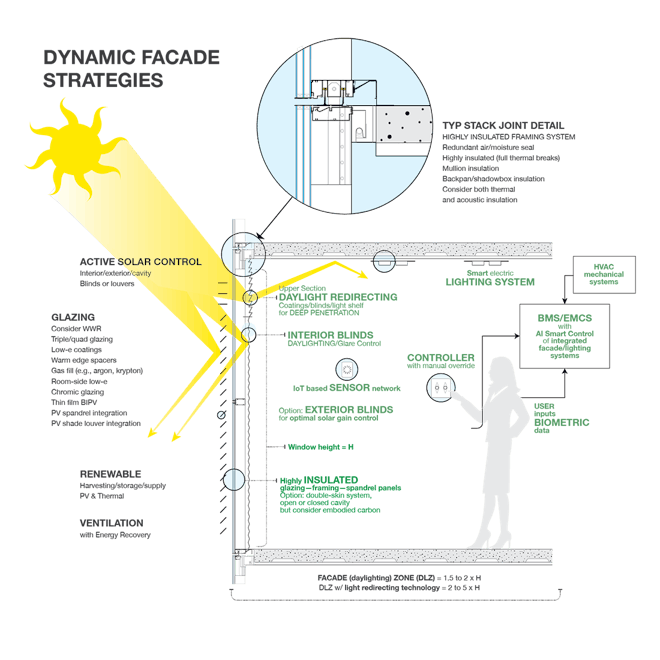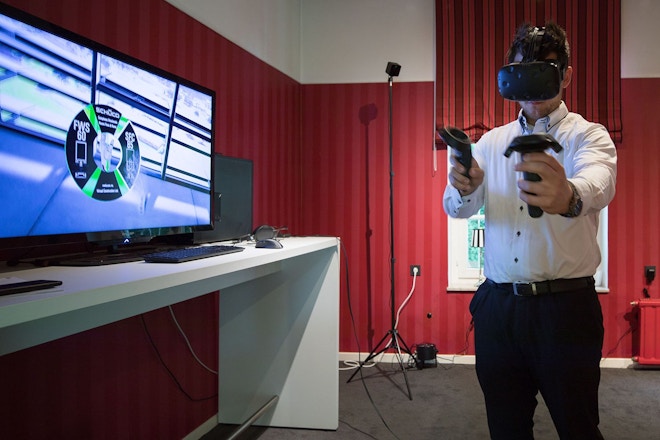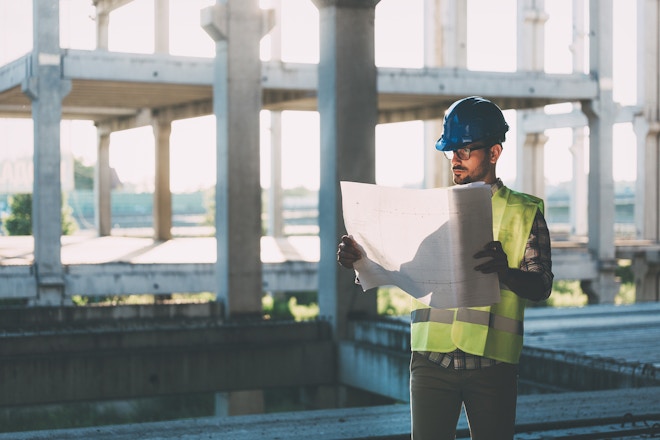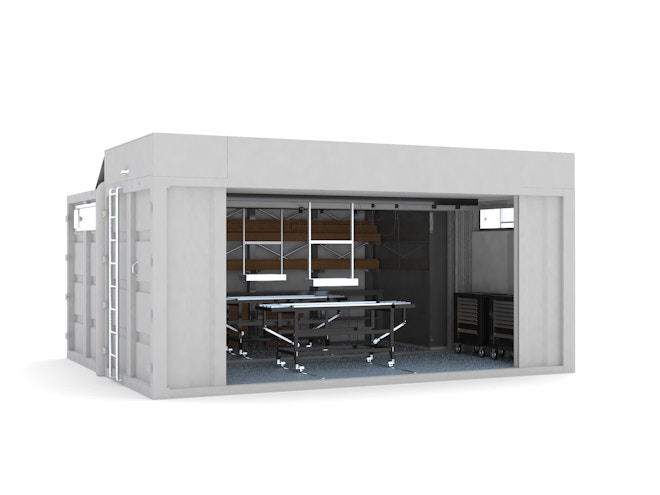
Facade Futures 2018: Considering long-term trends in curtainwall technology

Yeah, sorry; my crystal ball looks like roiling black coal smoke. But now that the year’s opening cacophony of “look-backs” and “new year trends” has subsided—the pursuit of ever bigger glass lites, the escalating geometric complexity in the building skin, the expanding palette of facade materials, dynamic systems, etc.—let’s take some time to consider the deeper trends and drivers that may shape building and facade market practices over a longer timeframe of years and decades, call it out towards 2050. Much will depend on the volatile vagaries embedded in the evolving conditions wrought by climate change, social strife, and their effect on the economy. But given a trajectory rooted in recent past decades certain patterns can be discerned, patterns that themselves suggest the potential for market disruption. There is a great deal to discuss in this regard, but eight of these patterns are explored following.
1. Disruptive Potential

Heads up! The facade industry is ripe for disruption. Aluminum and glass curtainwall systems have changed remarkably little since their introduction in the mid-twentieth century. The biggest advance has been the development of unitized systems in the 1980s, which complicated design and engineering but shifted much of the site work to the factory, providing both improved quality and lower labor costs. There have been continual refinements, of course, and today’s unitized curtainwalls are sophisticated highly-engineered systems with significant performance improvements over their progenitors. But, as has been discovered in broad arenas of industry and the sciences, over-specialization can limit adaptive capacity and resilience, the forbearer of potential market disruption and regime change. The decades long pursuit of economic and performative efficiencies may have dead-ended the current manifestation of curtainwall technology in terms of its adaptability to changing market demands. A symptom of this? The facade and construction industry has caught the attention of venture capital interests and diverse startups are popping up ranging from new architectural glass products to sophisticated cloud-based project management systems. New tools are emerging at a pace challenging the industry to keep up. Regard these all as catalysts with transformative potential.
2. Sustainability is Dead: Long Live Sustainability!

I’ve heard the clarion call for sustainable development, back even before the terms “green” and “sustainability” entered the building lexicon. I’ve heard more recently that sustainability is dead, that resilience is the new sustainability. Now we are talking zero-carbon and human-centric building design with limited understanding of the true significance of these terms. Our inability to converge on key definitions for these and other pivotal concepts in the building industry is contributory to the persistence of social, environmental and economic impacts eliciting from the building sector. These impacts are building to threaten civilization as we know it, yet mitigation response remains inadequate and too slow. There is yet far to go in the attainment of critical sustainability goals. Our current understanding of the attributes of sustainability and resilience remain superficial, even more so the pathway to attainment. Nonetheless, evolution of buildings and building practices toward a truly sustainable and resilient built environment—whatever we may call it—will accelerate, ultimately driven by the press of necessity.
<h2>3. Rise of the Building Skin</h2>
The recognition of the central role of the building facade in architecture, uniquely effecting attributes of both appearance and performance, is gaining traction in the industry, especially with architects and engineers but increasingly too with building owners. The current pursuit of the iconic in contemporary commercial architecture keeps the focus on considerations of appearance, and it is easily seen how aesthetics and not performance is the essential driver. Which is not to deny the presence of relevant attributes of performance, but much of this accomplishes relatively little in the pursuit of sustainable buildings and urban habitat. Mounting environmental threats and social strife resulting from climate change impacts will yield a shift in coming years, bringing increased priority to performance. Building scientists will rise in prominence as actors in building projects. This will gradually be reflected in academia, where facade-centric foundation classes and advanced degree programs will become increasingly commonplace and sophisticated—as has already happened in Europe—with a partial migration of students from university design curricula to facade design/engineering programs. This is appropriate to balance aesthetic drivers in facade design, but certainly not to replace or compromise them. Aesthetic considerations are an important attribute of resilience and sustainability; beautiful buildings and urban habitat are cherished, maintained and protected.

The recognition of the pivotal role of the facade system in building performance is being accompanied by, and perhaps driven by, the progressive integration of the building skin with the other major building systems through increasingly sophisticated automated building management technology. Take the emergence of closed-cavity (pressurized) facade systems, for example, which typically integrate electrical and plumbing as well as automated shading devices linked through sensors and controls to the electric lighting and mechanical systems. This effectively broadens the scope of the facade as a building system to the extent that the boundaries are blurring; it’s difficult to define precisely where the facade begins and ends, both physically, with multi-layered systems, and digitally, with integrated functionality networking deeply into other major building systems. Note that the scope of work for the facade designer/engineer will expand accordingly.
4. Technological Optimism

Will technology come to our rescue? Or will our reliance on potential future tech fixes delay technical and social transitions necessary to prevent debilitating societal disruptions? Regardless, technology will play an increasingly influential role in evolving building and facade system design and delivery practices. Technology is invariably the focus in market look-ahead. The pull of technology seems irresistible, even while we question whether things are truly improving. Our smart phones have increased messaging by many orders of magnitude, but has real communication increased? And what about knowledge and wisdom as the essential product of communication? A prominent facade designer for a leading architect expressed frustration to me only today, “We are supposed to be getting smarter [at building] but we’re not; I swear we were smarter back in the 80s.” (I’ll tackle this issue in another article.) Emerging technologies will certainly play an increasing role in facade design and delivery; robotics, digital printing, augmented and virtual reality (AR and VR), artificial intelligence (AI), voice-user interfaces, and other advanced digital processes, accompanied by the surge of the internet-of-things (IoT), are already shaping the future of construction and the building skin.
5. Humanizing the Facade Zone, Dynamically
Buildings will become smarter, facades will become more dynamic, and the building/user interface will become far more intimate and individualized. Users will engage with their workspaces unlike ever before. While it can be challenging even to get users to adjust blinds in response to changing exterior lighting conditions, emerging automated technologies will tune basic workspace conditions to each user. At the same time, users will be enabled to interact with individual workspace conditions in a manner more akin to how they engage with their smart devices, through graphic, motion, and voice user interfaces integrated into those very devices. Public workspace will become more diverse, subjecting users to a range of interior environmental conditions (ambient temperature, humidity, acoustics, color, density and conditions of use) as they move through their workday.

The building industry is happily (re)discovering that buildings exist to make people’s lives better. The relatively recent amplified recognition of and refocusing on the importance of human health, comfort and productivity as the overarching priority of this sustainability pursuit is here to stay. We spend 90% of our time indoors, on average. We will see a steady progressive shift to human experience and comfort as the dominant performance criteria. Studies have definitively linked attributes of the interior environment to health and productivity, both of which have a significant impact on efficiency in the workplace, a factor that business owners are realizing transfers directly to the bottom line. Biophilic considerations of daylight, fresh air, view and a connection with nature are being layered over the existing drivers of energy and thermal performance. In response, facade systems will become more complex, dynamic and interactive, able to adapt in various ways to a variety of external, internal and user inputs. Building Management Systems (BMS), increasingly driven by AI, will monitor biometric data from occupant’s smartphones and other sensory feeds to adjust environmental workspace conditions to suit individualized preferences, which the BMS will have learned over time. A Voice User Interface (VUI) will allow occupants to adjust these conditions through simple voice expression: “I’m too warm,” or “lower ambient light level,” or just “Open the bloody blinds!” This technology already exists and is rapidly increasing in sophistication; hello Alexa, Siri, Cortana and OK Google. Voice-based systems are growing to dominate our interactions with technology, and this will include, and to a large extent define, our relationship with building and workspace.
6. Material Concerns
Procurement practices and legislation—such as recently adopted in California and under consideration in the State of Washington—will accelerate the uptake of environmental product declarations (EPDs) and bring growing importance to the embodied carbon impacts of material selection. EPDs reveal material toxicity and global warming potential (GWP), among other important material consideration. This influence will result in shifting procurement patterns; the sourcing of domestic architectural glass supply, for example, where manufacturing energy is supplied through cleaner sources than offshore producers (e.g., natural gas verses coal), along with proximity factors, yield enhanced sustainability attributes. Another example will be amplification of the recent interest in the use of timber resources in building construction, a budding revolution in material utilization. Wood products have the advantage of a significantly lower embodied carbon manufacturing profile than steel or concrete, with the added benefit of sequestration, whereby carbon is removed from the atmosphere through the process of photosynthesis and stored in the wood for the lifetime of the material (until combustion or decomposition). Mass timber in tall building applications is under investigation as an alternative to steel and reinforced concrete structural systems, with viable options already at over 40 stories and more.
The most effective measure to reduce lifecycle embodied carbon is extending the service life of a material, component or system, including a building and its facade system. This will bring considerations of durability and adaptability to the forefront as design drivers. Buildings today, even very large buildings touted as high-performance and green—LEED Platinum examples among them—are implemented with no definition of intended service life. (Current building service life parameters, to the extent they exist, will ultimately be found far too short with respect to their material resource consumption.) As buildings are designed to last longer, they will need to become more adaptable to withstand the various forces of obsolescence (technological, social, cultural) that can prematurely end service life. Current building structure and facade systems fail to anticipate and accommodate future needs for maintenance, rehabilitation and adaptation, and ultimately, end of life repurposing or recycling. Addressing these shortcomings will fundamentally change the design and delivery practices for buildings and their major systems.
7. Alternative Project Delivery

The biggest changes may come in the manner in which buildings are delivered, the actors, the stakeholders, their relationships and responsibilities. The still emerging collaborative practices, like design-assist and integrated project delivery, have been among the most useful innovations in the building industry in the past decade, particularly with respect to facade delivery. The integration of these processes is certain to continue because of the efficiencies produced and the risk mitigation they bring to the stakeholders, particularly the developer. The future building developer is likely to benefit from some significant consolidation in the building process, perhaps dealing with just three primary contracting entities: structure, shell and systems (MEP, lighting), and interior finishes. The shell and systems are becoming increasingly integrated; think daylighting and the relationship between the facade system, shading systems, electric lighting systems and the BMS. Double-skin facades now frequently involve plumbing, electrical and mechanical components to pressurize and condition the cavity between the skins. A contractor willing to provide this entire scope as a single-source warrantied product to a building developer will emerge as a market leader. We’ll likely see future facade contractors looking to acquire lighting and MEP capabilities, or leading HVAC contractors looking to acquire curtainwall delivery capabilities, or some other variation of scope consolidation.
A more radical concept is that of facade system leasing. Bruce Nicol and others have pointed to the compelling logic of leasing a facade system as a viable buying alternative for building developers. This strategy opens the potential for higher performing facades that mitigate risk to the building owner at little or no cost premium. The concept integrates the notion of highly adaptive facades that are easily maintained, repaired, upgraded and renovated, new drivers that would fundamentally change the design of contemporary curtainwall systems.
8. Modular Prefabrication

Prefabrication and modularization strategies are slowly being adopted as mainstream construction practices, but this is just scratching the surface of this compelling opportunity that will ultimate bring great change to the building design. Modularity will be rediscovered and embraced because of the efficiency it brings to the spectrum of building processes, but this won’t be the monotonous orthogonal grid-work of early Modernism. Rather, geometrically intricate close-packing cellular structures will be developed as a means to efficiently express complex architectural form, much as nature does. This will enable a diversity of form without the penalty of excessive component differentiation that, in spite of evolving automation technology, still amplifies risk and cost throughout the building process. Modularity will be coupled with increasingly sophisticated prefabrication processes that will see ever-larger prefabricated units assembled under automated factory-controlled conditions. But these may not be units assembled in remote factories and shipped to the jobsite. Rather, the site or building can be developed as a temporary automated factory. Modular automated and environmentally controlled fabrication and assembly units can be installed on the jobsite or on a completed lower floor of the building while under construction. A sophisticated supply chain can then deliver the materials, products and components required for the fabrication and assembly units to produce a choreographed sequence of prefabricated modules integrating all major building systems. Automated processes will next position the modules and fix them in place, defining the buildings form and interior spaces.
In summary, the future is more uncertain than ever it has been for this recent manifestation of civilization, seeded as it is with potent unknowns and unknowables produced, essentially, by our past technological success. Yet how this future will unfold remains largely in our hands, with outcomes dependent upon our ability to anticipate and implement needed change. Embracing innovation, regardless of how desperately it may be needed, is never been a strength of the risk-averse building industry. There is certainly cause for concern. Our understanding of the various impacts of the built environment were slow in coming and have been slow in developing, and even more so our progress in mitigating and ultimately eliminating these impacts. There is much to talk about, and even more to do, and the urgency amplifies with each passing day. Facilitating this dialogue and action is the critical mission of the Facade Tectonics Institute and other similar organizations. If you have not already, join the dialogue and become a player in what may become humanity’s greatest—or final—act.

Mic Patterson, PhD, LEED AP BD+C
Ambassador of Innovation and Collaboration
Facade Tectonics Institute
Send Email
Mic Patterson is a designer, researcher, educator, futurist, author, photographer and entrepreneur. He has concentrated his professional and academic career on advanced facade technology and sustainable building practices. He pioneered the introduction of structural glass facade technology in the United States in the 1990s, implementing diverse and novel applications including cable trusses, cable nets and grid shells. Patterson was among the founding group of the Advanced Technology Studio of Enclos, where he works as the Vice President of Strategic Development. He is a co-founder of the Facade Tectonics Institute and serves on the steering committee, and co-founder of the Facades+ conference series. He is on the technical research committee for GlassCon Global and a member of the Advisor Group for the Council for Tall Buildings and Urban Habitat. He has twice been named among the industry’s most influential by US Glass magazine. Patterson is a Ph.D. candidate in the School of Architecture at the University of Southern California with a research focus on sustainable facade renovation practices. He has taught, written extensively, and lectured internationally on diverse aspects of advanced facade technology. He is the author of Structural Glass Facades and Enclosures, published by Wiley.
Publisher’s note: The views expressed here are those of the author, and do not necessarily reflect those of, nor are they endorsed by, the Facade Tectonics Institute.
Looking for something specific?
Search our extensive library.
FTI’s SKINS email is the central source for the latest in building skin trends and research.
All emails include an unsubscribe link. You may opt out at any time. See our privacy policy.








